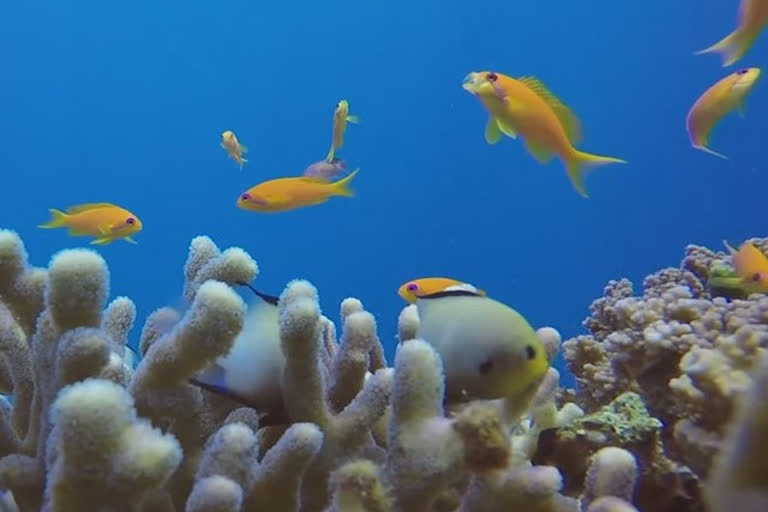Eilat: As the outlook for coral reefs across a warming planet grows grimmer, scientists in Israel have discovered a rare glimmer of hope.
The corals of the northern Red Sea may survive, and even thrive, into the next century.
There is broad scientific consensus that the effects of climate change have devastated the world's reefs, recently ravaging large swaths of the Great Barrier Reef in Australia, one of the natural wonders of the world.
But, the corals at the northernmost tip of the Red Sea are exhibiting remarkable resistance to the rising water temperatures and acidification facing the region.
This is according to research conducted by the Interuniversity Institute for Marine Sciences based in Eilat, Israel.
The carbon dioxide that humans release into the atmosphere raises the temperature and the acidity of seawater, which can both poison corals and hamper their growth.
Scientists estimate that half of the corals that existed in the early 20th century have died.
"Corals worldwide are dying and suffering at a rapid pace, but we have not witnessed a single bleaching event in the Gulf of Aqaba," says Maoz Fine, expert on coral reefs at Bar-Ilan University and director of the research.

Overheated water forces corals to eject the brightly colored plants inside their tissue that serve as their primary food and oxygen source.
This causes reefs to "bleach," or take on a bone-white pallor that often indicates that mass mortality is a risk.
Fine examines mini corals in water treated to simulate future global warming scenarios.
Their ruddy color as a sign of good health.
"We've exposed our corals to bleaching conditions and coral bleaching conditions are usually considered as one to two degrees above the summer maximum, the summer maximum temperature, so this is exactly where we started - we exposed them to these temperatures. "And there was no bleaching, they didn't bleach, the symbionts (symbiotic organisms) were okay, they felt alright, and so we continued. We elevated the temperature further more, and three degrees and four degrees and five, and only at five and six degrees above summer maximum, they showed signs of stress and bleaching" says Fine.

The Gulf of Aqaba has become a refuge for tough corals that are projected to outlast far worse future conditions.
While other hardy coral species can be found in the Indian and Pacific Oceans according to Fine there is nowhere else in the world where reefs are as untouched by bleaching as those from the Gulf of Aqaba.
"During the Last Glacial Maximum (ice age), sea water in the Red Sea dropped by about 120 meters below what it is right now, which means that the Red Sea, the entire Red Sea, was separated from the Indian Ocean or the Gulf of Aden, and this resulted in high salinity and mortality of most of the corals and other organisms that lived here as we understand it."
Fine's research credits northern Red Sea coral resilience to a giant natural selection event that occurred some 18,000 years ago.
As glaciers retreated at the end of the ice age, reefs moved to recolonise the southern part of the sea, where temperatures ran exceedingly high.

Only corals that could bear the heat managed to reach maturity and migrate north, where they resettled in conditions several degrees cooler than their thermal threshold
"In order to survive conditions, very hot conditions, in the southern Red Sea, they had to be or undergo selection toward thermally resilient corals. Those that suffer from the hot, the very hot conditions down there, didn't survive. And so corals that we see here nowadays are the ones that are descendants of the ones that survived, that underwent that selection in the southern Red Sea."
"So, that is to say they underwent selection to thermal resilience and tolerance, but now in the Gulf of Aqaba they live in temperatures that are five and six degrees lower than what they were selected for. So, we end with a kind of a gap between what they are capable to withstand and what they are experiencing in practice, in real time" Fine explains.

Fine's latest study, published in the Journal of Experimental Biology, found further cause for optimism: the coral species' thermal resistance carries over to their offspring.
This indicates that future generations of coral will remain as immune to bleaching as their parents, with implications that could extend beyond this one spot of the Red Sea.
Further research is underway to determine how existing in temperatures below their tolerance levels may lend corals physiological benefits
"To understand how species may acclimate or be able to adapt to climate change that we expect to be seeing over the next century, it is very important that we conduct more of these kinds of studies, to see what happens with a parental environmental suffers or changes, what happens onto the offspring, and this will give us information on how well species will be able to adapt or not, to continue to survive or not, and into the future" says Jessica Bellworthy a PhD student in Professor Fine's coral lab.

Reef death not only carries dire consequences for wildlife, but also for the homes, health and livelihoods of hundreds of millions of people: those who fish, work in tourism, dwell on islands made of coral or rely on reef protection from coastal erosion.
Bellworthy says millions of people depend on the existence of coral reefs.
"It's estimated that around the world something like 500 million people depend directly on the existence of coral reefs. So, without coral reefs we lose income economically, we also risk our food source, and we also risk our livelihoods or our homes."
Apart from global warming other threats to corals include local stresses like overfishing, pollution and the jewellery trade.



